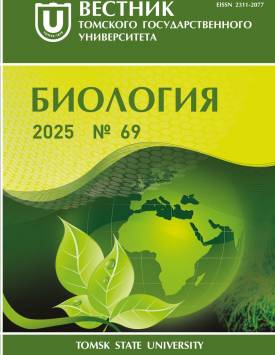Targeted editing of human induced pluripotent stem cells genomes as a tool for functional analysis of genetic variants
The creation of models that are designed to study the molecular genetic mechanisms of disease development, search for target molecules and test potential drugs and technologies is one of the current areas of modern biomedicine. An alternative to the use of animal models is cellular models, in particular those based on the use of differentiated derivatives of induced pluripotent stem cells. Genome editing tools, for example, CRISPR-mediated systems, make it possible to artificially create various genetic variants (single nucleotide polymorphisms, deletions, insertions, etc.), and can also be used to stimulate homologous recombination during targeted transgenesis. The combination of these systems with the technology of induced pluripotent stem cells makes them a unique tool for creating models of human hereditary pathologies. In this work, we used clones of human induced pluripotent stem cells of the ICGi022-A line (https://hpscreg.eu/cell-line/ICGi022-A), which carry transgenes of two variants of the AsCas12a nuclease that recognize different PAM consensuses (ICGi022-A-6 (As-Cas12a, PAM 5'-TTTV-3') and ICGi022-A-7 (AsCas12a, PAM 5'-TYCV-3')), and the reverse doxycycline-dependent transactivator transgene M2rtTA. The work also used induced pluripotent stem cells from a healthy donor and a patient with the genetic variant c.2013T > G (rs63750756, p.N279K) in the MAPT gene. All lines of induced plu-ripotent stem cells were obtained by the authors previously. Protospacers for AsCas12a were selected using the Benchling platform (https://www.benchlrng.com/). The selection took into account potential off-target activity and proximity to the point of interest in the genome. Constructs for expression of AsCas12a gRNA were created based on the pTE4560 vector (Addgene #107526). T7EI analysis was used to study the efficiency of AsCas12a. Gibson's method was used to assemble the pSOX6-T2A-EGFP-HygroR plasmid construct. To obtain clones of cells with the MitoTimer transgene, pX458-AAVS1 and pAAVS1-TRE-mCMV-MitoTimer constructs created by molecular cloning were used. The donor plasmid AAVS1-Neo-M2rtTA, encoding the reverse tetracycline transactivator, was obtained from the Addgene depository (Addgene #60843). PCR was used to analyze transgenic cell clones. The creation of isogenic cell models, including knockout cell lines and lines carrying various genetic variants (single nucleotide polymorphisms, deletions and insertions), as well as transgenic cell lines, is an urgent biomedical task. Our study shows that the programmable nuclease AsCas12a (PAM consensus - 5'-TTTV-3') introduces double-stranded DNA breaks in the loci of the genomes of human induced pluripotent stem cells, which are associated with neurodegenerative and cardiovascular diseases (MYBPC3 - efficiency (T7EI) 16.2 ± 1.42% and 13.4±0.91%, APOE - 25.3 ± 1.76%, LRRK2 - 23.5 ± 1.86% and 11.4 ± 0.04%, PRKN - 20.6 ± 0.63% and 9.6 ± 0.01%, PSEN1 - 3.3 ± 0.01% and 4.2 ± 0.01%, PINK1 - 8.0 ± 0.02%) , which makes it a promising tool for knocking out genes and stimulating the process of homologous recombination in this type of cell. In this case, induced plu-ripotent stem cell lines carrying the doxycycline-driven transgene for the programmable nuclease AsCas12a can be used to create isogenic cellular models of pathological processes. In addition, it was established that in the line of human induced pluripotent stem cells carrying the AsCas12a transgene (PAM consensus - 5'-TYCV-3'), successful As-Cas12a-mediated homologous recombination of the 3' region of the SOX6 gene occurs with the plasmid donor construct, which is intended to mark the expression of the SOX6 transcription factor using the fluorescent protein EGFP, which shows the promise of using this cell line to create transgenic human induced pluripotent stem cells. By CRISPR/SpCas9-mediated homologous recombination at the AAVS1 locus, three clones of induced pluripotent stem cells from a healthy donor and four clones of induced pluripotent stem cells from a patient with the genetic variant c.2013T > G (rs63750756, p.N279K) in the MAPT gene, which carry doxycycline, were obtained -transgene-driven biosensor MitoTimer. It was confirmed that the resulting transgenic clones of induced pluripotent stem cells express markers of self-renewal and pluripotency of human cells, have a normal karyotype and can be differentiated into derivatives of the three primitive germ layers - ectoderm, mesoderm, endoderm. Thus, the combined use of induced pluripotent stem cell technology and programmable nucleases AsCas12a and SpCas9 makes it possible to create a wide range of cellular models, including plu-ripotent cell lines with knockout of genes associated with hereditary human diseases, and transgenic lines designed for live-cell visualization of cellular processes. The article contains 8 References. The Authors declare no conflict of interest.
Keywords
induced pluripotent stem cells, cell models, Parkinson’s disease, frontotemporal dementia with parpinsonism-17, genome editing, AsCas12a, SpCas9Authors
| Name | Organization | |
| Medvedev Sergey P. | Institute of Cytology and Genetics, SB RAS; Institute of Chemical Biology and Fundamental Medicine, SB RAS | medvedev@bionet.nsc.ru |
| Akhmerova Valeria I. | Institute of Cytology and Genetics, SB RAS; Novosibirsk State University | v.akhmerova@g.nsu.ru |
| Nadtochy Julia A. | Institute of Cytology and Genetics, SB RAS; Novosibirsk State University | y.nadtochii@g.nsu.ru |
| Grigor’eva Elena V. | Institute of Cytology and Genetics, SB RAS; Institute of Chemical Biology and Fundamental Medicine, SB RAS | evlena@bionet.nsc.ru |
| Pavlova Sofia V. | Institute of Cytology and Genetics, SB RAS; Institute of Chemical Biology and Fundamental Medicine, SB RAS | spav@bionet.nsc.ru |
| Zakian Suren M. | Institute of Cytology and Genetics, SB RAS; Institute of Chemical Biology and Fundamental Medicine, SB RAS | zakian@bionet.nsc.ru |
References

Targeted editing of human induced pluripotent stem cells genomes as a tool for functional analysis of genetic variants | Vestnik Tomskogo gosudarstvennogo universiteta. Biologiya - Tomsk State University Journal of Biology. 2025. № 69. DOI: 10.17223/19988591/69/13
